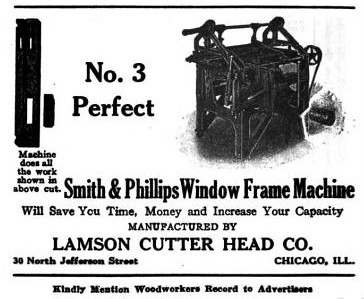In 1888, William Henry Lamson, a successful architect and real estate developer, was granted a patent for a type of sawblade that could be used to cut dadoes and rabbets. Lamson Cutter Head Company was formed: it was in business by 1902, and was probably established shortly after the patent was issued. Besides their line of cutter-heads, they made a window-frame machine. They also sold used woodworking machinery. The company survived at least into the late 1940s.

Ad from May 1920 issue of "Woodworkers Record"
See also the entries for Smith & Phillips Manufacturing Co. and Atlas Manufacturing Co.
We have several reports of 26" or 27" bandsaws from this maker. In fact, these saws were made by Sidney Tool Co., and sold by Lamson, complete with a large "Lamson Cutter Head Co." name plate. (We have seen Chicago Machinery Exchange named as the likely maker of the Lamson saws, but in fact CME's 27" bandsaws were also made by Sidney.)
Information Sources
- The Directory of Directors in the City of Chicago, Volume 1902 lists "DIGNAM, PETER A., 18 South Canal Street. Lamson Cutter Head Co., President and Director."
- Listed in a 1906 issue of Wood Craft journal.
- A 1920 issue of Industrial Woodworking has a listing of used machinery available from Lamson Cutter Head Co. The address was given as 30 N. Jefferson St., Chicago. The last item listed is "Window Frame Machines, new, Smith & Phillips Mfg. Co."
- An ad in the May, 1925 issue of The Wood-Worker says that this company are "Manufacturers of the Smith & Phillips Window Frame Machine".
- A 1940 Penton's Almanac lists "Peter A. Dignam, president, Lamson Cutter Head Co., Chicago."
- A 1948 Hitchcock's Wood Working Digest lists Lamson Cutter Head Co. of Chicago.
- A correspondent reports a 26" bandsaw with "Lamson Cutter Head Co." cast into the base, and bearing a metal tag saying, "Gustafson & Scott Mfg. Co. / Manufacture and repair of saws, knives, cutters and specialty tools woodworking machinery / Chicago, Illinois". However, we have not actually seen this for ourselves. We have seen one saw where the Lamson name is on an applied plaque, and we suspect this is also the case for the reported saw. As mentioned, the examples we have seen were actually made by Sidney Tool Co.
- The book Descendants of William Lamson of Ipswich, Mass., by William J. Lamson, 1917, has this biography:
WILLIAM HENRY LAMSON was born at Atkinson, Me., May 8, 1853, and died at Chicago, Ill., Jan. 25, 1896...
William Henry Lamson received his early education in the public schools of Maine, and then, having a decided bent for architecture and mechanics, he went to Boston, Mass., in order to take up the study of these branches. He became so proficient that he was selected by the Government for the responsible task of building Fort Assinaboine, in Montana. He spent one year at this work, and it was so satisfactory that on his return to the East he was retained in the Government service for a number of years. In 1885 he left the employ of the Government, and went to Chicago, where he erected many fine residences, apartment buildings, and business blocks in the City of Chicago and vicinity. One of his mechanical inventions was the Lamson Cutter Head Saw, which is in general use throughout the country.
He was clever and genial, and had the advantages of wide travel, culture and experience. He was more than ordinarily skilled in music, and was a fine performer of the violin. He was a member of the West Side Military Band. While living in the East, he belonged to the Vermont Rifle Corps, and for many years held a championship medal. He was a Master Mason and an Odd Fellow. He was a Charter Member of the well-known West Side Club, the "Menoken," and his popularity with the member of these various societies was frequently shown.
- Thanks to John Orvis for helping to determine the maker of the Lamson-badged 27" bandsaws that we have seen.